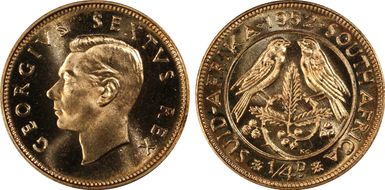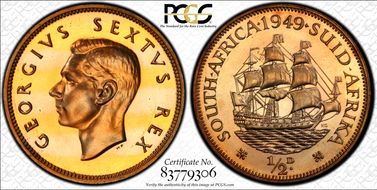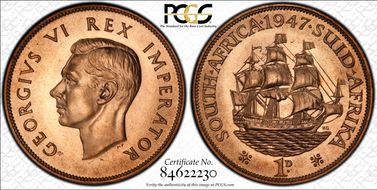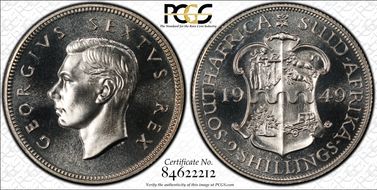SWvdM 的钱币相册
*1937* King George VI was crowned in 1937 and his likeness replaced King George V on all coinage of the British Empire. He faces left and although it is custom that each new monarch faces the opposite way of the previous monarch, the abdication of Edward VIII, after a short reign, resulted in King George VI facing the same way as King George V. There were no coins struck for King Edward VIII in South Africa (some patterns exist). The obverse design: head of King George VI. Inscription: GEORGIVS VI REX IMPERATOR. Designed by Henry Paget (HP). The reverse design: A circle containing two sparrows, facing each other, sitting on a branch of a Mimosa tree. Inscription: SOUTH AFRICA to the left and SUID-AFRIKA to the right of the coin. The date top center and the denomination "1/4D." bottom center. Designed by Kruger Gray (KG). *1948* A design change was made to the obverse of the coin. The inscription was changed to GEORGIVS SEXTUS REX. With the independence of India in 1948, Great Britain was no longer regarded an empire and thus the removal of the word "IMPERATOR". *1951* A design change was made to the reverse of the coin. The Afrikaans "SUID-AFRIKA" moved to the left of the coin and "SOUTH AFRICA" to the right. The fonts were changed for all text.
*1937* King George VI was crowned in 1937 and his likeness replaced King George V on all coinage of the British Empire. He faces left and although it is custom that each new monarch faces the opposite way of the previous monarch, the abdication of Edward VIII, after a short reign, resulted in King George VI facing the same way as King George V. There were no coins struck for King Edward VIII in South Africa (some patterns exist). The obverse design: head of King George VI. Inscription: GEORGIVS VI REX IMPERATOR. Designed by Henry Paget (HP). The reverse design: The center of the coin shows the figure of “HOPE” symbolizing the Cape Province. She is standing with her right elbow resting on an anchor with drapes blowing in a light wind. She is facing right and gazing over the ocean. A six-pointed star flanks her left shoulder. Inscription: “SOUTH AFRICA” to the left, the date at top center, “SUID-AFRIKA” to the right and “SHILLING”, flanked by two little flowers to the left and right, at the bottom center. Reverse design artist: Kruger Gray (“KG” underneath the flowing drape). *1948* A design change was made to the obverse of the coin. The inscription was changed to GEORGIVS SEXTUS REX. With the independence of India in 1948, Great Britain was no longer regarded an empire and thus the removal of the word "IMPERATOR". *1951* A design change was made to the reverse of the coin. The fonts were changed for all text. The word “SHILLING” was replaced by “1S.”.
1952 saw the return of gold proof coins to the annual, so called, Long Proof set. Before that, only the 1923 South African Proof set contained the Sovereign and Half Sovereign. This is the only set that has King George VI's image on it's gold coins, other than the set from Great Britain of 1937, in all of the British Commonwealth. The £1 Pound, or 20 Shillings (Sovereign) and £1/2 Pound, or 10 Shillings (Half Sovereign), have the exact dimensions of it's British counterparts. The obverse of these coins were designed by Henry Paget (HP) and the reverse of the coins were designed by Coert Steynberg (CLS).


























